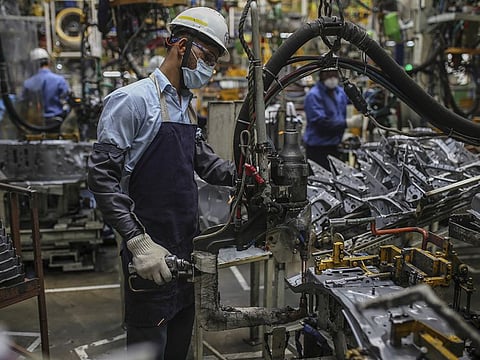How long will COVID-19 scar the Indian economy?
Economy to stage quick recovery this year, but long-term worries are here to stay

Dubai: While the Indian economy is expected to rebound strongly this year, the negative effects stemming from the ongoing COVID-19 health crisis is seen continuing for a prolonged period.
The Indian economy will suffer lasting damage from the current coronavirus crisis and after an initial strong rebound in fiscal year ending March 2022, the growth will slow to around 6.5 per cent a year from the following year up until fiscal 2026, analysts at US-based Fitch Ratings recently revealed.
The coronavirus pandemic has stifled economic growth and led to job losses in the several sectors and subsequent demand destruction in the bottom of the pyramid section of the economy, but analysts have been expecting the economy to grow somewhat faster than estimated over the medium term.
Headwinds to continue
“The latest monthly activity data suggest that investment growth recovered further in the fourth quarter,” noted Darren Aw, Asia economist at UK-based Capital Economics. “The rebound should continue over the coming months, but is likely to slow in the second half of the year as banking sector concerns come to the fore.”
Restricted credit supply amid a brittle financial system has been a key headwind for investment. The banking sector entered the crisis with weakness in asset quality and controlled capital buffers, with lending now seen further dampening as rolled out credit-guarantee and forbearance steps start to relax.
“A combination of supply-side scarring and demand-side constraints -- like the weak state of financial sector -- will keep the level of GDP well below its pre-pandemic path,” noted the global credit rating agency, which is one of the ‘Big-Three’ agencies - the other two being Moody’s and Standard & Poor’s.
Easing lockdown helped
The coronavirus-induced recession in India has been among the most severe in the world amid a stringent lockdown and limited direct fiscal support and the economy is now in a recovery phase that will be further supported by the rollout of vaccines in the next months.
“The drop in new COVID-19 cases and the resulting scaling back of containment measures in India has provided a much-needed boost to the economy, and an effective vaccine will further support the recovery in 2021 and 2022,” evaluated Shilan Shah, senior India economist at Capital Economics.
“But even widespread vaccination won’t restore the economy to full health given the extreme weakness of the banking sector and tepid fiscal support,” Shah added. “Output is likely to remain below its pre-virus trend for many years.”
Concerns remain even after vaccine approval
Oxford Economics had recently revealed that India would be the worst-affected economy even after the pandemic eases, stating that annual output would be 12 per cent below pre-virus levels through 2025.
India’s economy had struggled to gain traction even before the pandemic, and the hit to global activity from the virus and the lockdowns that followed, combined, dealt the country a severe blow.
“The approval of COVID-19 vaccines in India were quicker than most had expected, but concerns over the approval process and pricing disagreements underscore some of the challenges that remain to widespread vaccination,” wrote Aw.
“On balance, we continue to assume that India’s most vulnerable will be largely vaccinated by the second quarter of 2022,” Aw added. “That would probably allow a rolling back of restrictions on most domestic activity during the second half of this year.”
Post-lockdown stimulus boost
The government announced stimulus packages after it lifted the lockdown imposed in March. In May, it introduced a $266 billion package to boost consumer demand and manufacturing. A large part of the package was actually loans provided by banks, many of them without collateral.
That was followed by a $35.14 billion package in November to stimulate the economy by boosting jobs, consumer demand, manufacturing, agriculture and exports hit by the coronavirus pandemic.
“India’s current account is likely to swing from an unprecedented surplus in 2020 back into deficit in 2021 as domestic demand rebounds and oil prices continue to recover,” wrote Shah.
“But when it does return, the deficit should remain small. And with capital inflows holding up well, the external position should remain secure for the foreseeable future.”
Sign up for the Daily Briefing
Get the latest news and updates straight to your inbox







